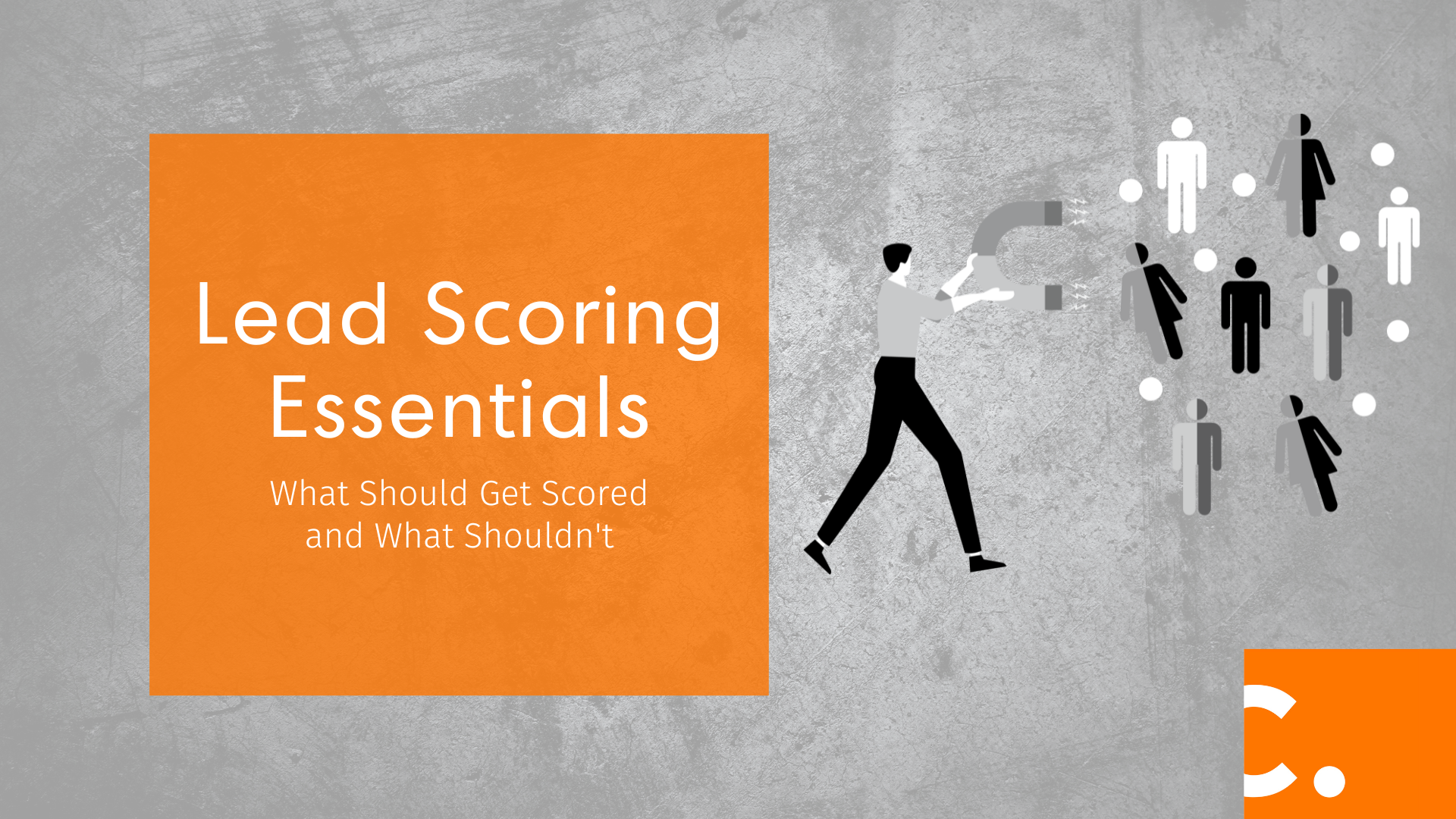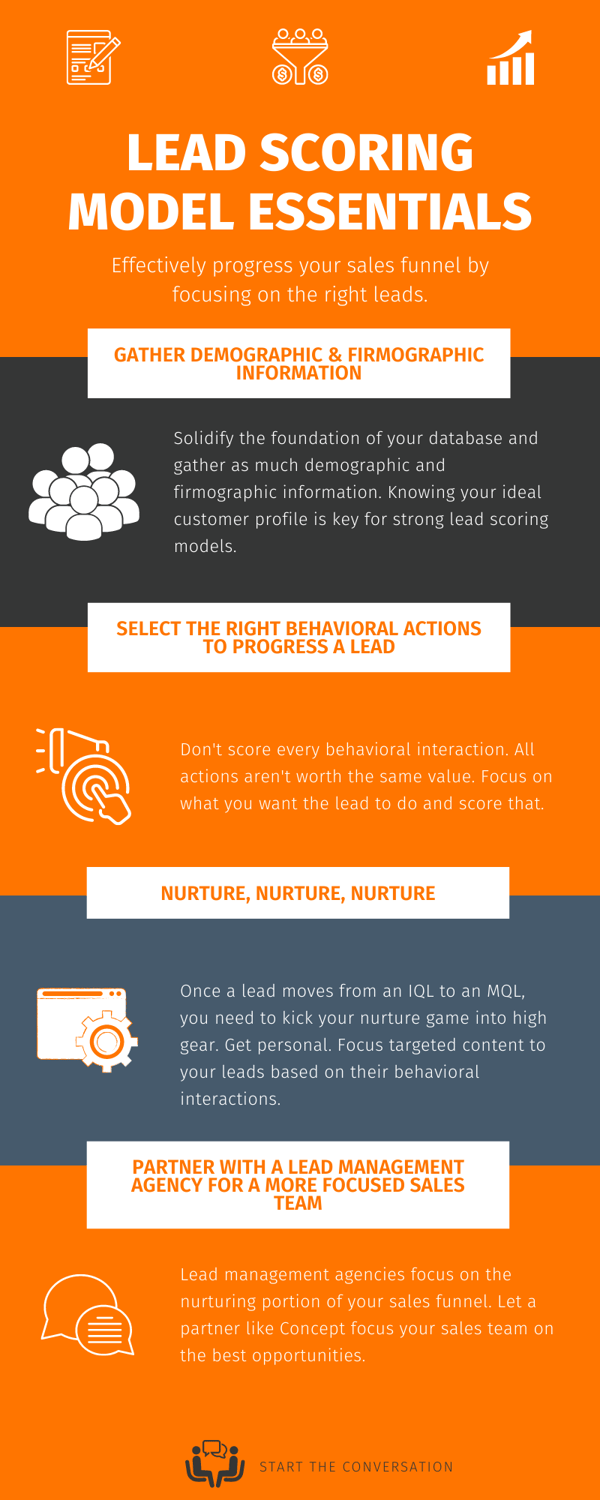
Sales teams are focused on turning opportunities into either closed-won or closed-lost deals. But every lead that your company has didn’t come in is an opportunity. So how does your business weed through the good leads and the bad leads? Most companies struggle with how best to identify and progress leads through their sales funnel – from information-qualified lead (IQL) to marketing-qualified lead (MQL) to SQL. Through an effective and targeted lead scoring model, you can focus your sales team’s attention on the higher quality leads.
-
Develop Lead Scoring Points to the Right Demographics and Firmographics
You don’t want every single lead to become an MQL, so how do you set a threshold that a lead can reach that truly represents an MQL?
First, you need to look at your current database of leads, prospects, and customers. How much and what kind of information do you have on your database? How often do they interact with your company – either through email engagement, website engagement, or maybe sales interaction? You need to consider how this information relates to your overall lead generation strategy.
From there, you can set a threshold for how much interaction and knowledge are needed to get a lead to an MQL. Whether it be 50 points or 100 points – you want to make sure that it’s attainable. And after implementing lead scoring, you may realize you need to either raise or lower the point total for MQLs.
-
Explicit and Implicit Scoring
Explicit lead scoring focuses on the information that the lead has willingly given up – their name, email address, age, gender, geography – as a few examples.
Implicit lead scoring focuses on the behavior and engagement of the lead with online behaviors – have they clicked on a link in an email you’ve sent; have they visited more than 2 pages on your website?
When considering explicit and implicit lead scoring models, focus on implicit scoring to gauge a lead’s interest in your service/product. Assigning point values that reflect behavioral actions are a major key to effectively progressing a lead. If you assign 50 total points for demographic information and 20 for behavioral, you aren’t really learning how interested the lead is in your offering.
Effective lead score modeling is key. Below is a chart illustrating how best to assign points for explicit and implicit scoring.
Let’s say that our threshold for a lead becoming a marketing-qualified lead is 60 points. And this lead filled out a form on our website after visiting 2 pages and provided their name, geography, email, and company.
Demographic & Firmographic Information
Name
Address/Geography
Age
Gender
Email
Job Title
Company3
2
1
2
5
7
10
Behavioral Information
Visited 1 page on your website
Visited 3 or more pages on your website
Clicked on a link in an email
Filled out a form
Placed a call
Registered for an event / webinar
Attended an event / webinar3
5
5
40
40
30
35
You’ll notice that the last 4 criteria in the behavioral category pushed leads right to being an MQL. It’s important that when a lead raises their hand, your sales team engages with the lead and nurture that lead to either a SQL or a not-qualified lead.
This lead scored 63 points from their demographic and behavior information and is now an MQL. So what happens next? Do you just let the lead sit there as an MQL hoping they’ll make a purchase or sign up for a service?
-
Nurture MQLs so they become SQLs and your sales team can focus on the more qualified leads.
That’s right – you need to continue the conversation with a MQL to stay top-of-mind and be their choice when it comes to purchase or add your service.
Nurturing leads can happen through multiple avenues – from one-to-one email communications using marketing automation to targeted content to people power connecting with the lead on a regular interval.
Marketing automation allows companies to create automated tasks, like sending follow-up emails on a set timeframe. Marketing automation can also create tasks for your sales team when a lead becomes an MQL.
If your business is struggling with the personal one-to-one follow-up, a lead management partner can be utilized to focus on nurturing leads from MQL to SQL. Lead management agencies provide sales development representatives (SDRs) to act as your pre-sales team which leaves your team focuses on the higher quality, sales-ready leads.
These three items don’t necessarily equal more closed-won opportunities. But these are essential to building a strong sales funnel foundation and effectively progressing leads. If you’d like to take your lead scoring and sales to the next level, start the conversation with a top lead management agency.
Partner With Concept
Share your details and our team will reach out to discuss collaboration opportunities



